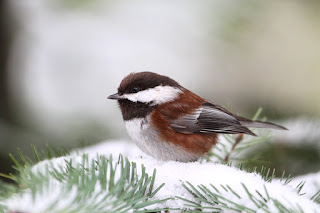Purple Finches are not regular visitors to backyard feeders, being more commonly spotted in wooded areas near city limits. They prefer to stay in their natural habitat, though Purple Finches will venture to backyard feeders if the natural seed is low.
Despite the name, the male Purple Finch is more of a raspberry-red colour on the face, head, and down their back. The wings appear more of a reddish brown, and this finch is about six inches in size, putting them at slightly larger than a House Finch. About the same size as a sparrow, they have the conical finch bill. Female Purple Finches are a heavily streaked brown bird with none of the colour of the males.
The House Finch is a similar species to the Purple Finch and they have been mistaken for each other at a glance, though the House Finch is a bit smaller and the red is concentrated on the throat, chest, and forehead. To help distinguish between the House and Purple Finches, look at the shape of the head. The House Finch has a rounded head on top while the Purple Finch is flat. The best way to tell which you have is to look at the females. The female Purple Finch has two white streaks on her head, one behind the eye with the other on her cheek, while the House Finch has no facial markings.
To attract finches to your yard, it's best to use black oil or hulled sunflower seeds. Black oil sunflower is better if your feeders are prone to moisture or aren't well-sheltered from the wet weather, as the shell lends some protection to the seeds. Hulled sunflower is great for drier weather or well-protected feeders, though it can absorb some moisture out of the air as it is a raw seed, and will attract finches and various other birds. Hulled sunflower is also better for keeping the area clean as it will not leave shell mess behind and all birds eat it, leaving little to no waste. Nyjer seed is also enjoyed by finches but the large conical bill of the Purple Finch makes them unable to get in to the tiny holes present on nyjer feeders. Purple Finches will also feed on fruits and berries such as those found on Hawthorns at Buttertubs Marsh. You may notice these birds in your bushes or shrubs before they go near your feeders.
When these birds nest they are not commonly found nesting in backyards. They nest in woodland areas and don't use nest boxes. Purple Finch build open nests with grasses and moss, then line it with fine grass or hair. The nests are usually build in conifer trees between 6 and 30 feet off the ground. The Purple Finch will usually have two broods of three to four young.
While they are uncommon visitors, they are not unheard of. A visit from the Purple Finch, along with other finches, will add colour to your backyard and your day.
Happy birding!

.jpg)





